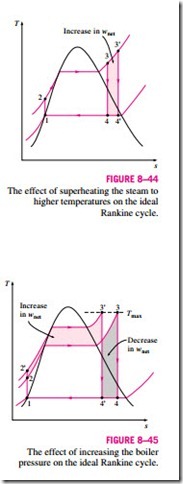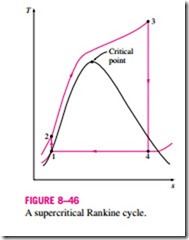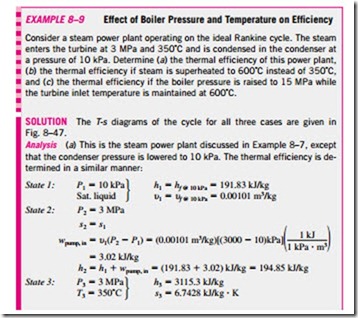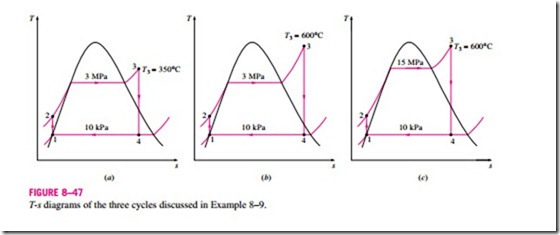■ HOW CAN WE INCREASE THE EFFICIENCY OF THE RANKINE CYCLE?
Steam power plants are responsible for the production of most electric power in the world, and even small increases in thermal efficiency can mean large savings from the fuel requirements. Therefore, every effort is made to improve the efficiency of the cycle on which steam power plants operate.
The basic idea behind all the modifications to increase the thermal efficiency of a power cycle is the same: Increase the average temperature at which heat is transferred to the working fluid in the boiler, or decrease the average temperature at which heat is rejected from the working fluid in the con- denser. That is, the average fluid temperature should be as high as possible during heat addition and as low as possible during heat rejection. Next we dis- cuss three ways of accomplishing this for the simple ideal Rankine cycle.
Lowering the Condenser Pressure (Lowers Tlow, av) Steam exists as a saturated mixture in the condenser at the saturation temperature corresponding to the pressure inside the condenser. Therefore, lowering the operating pressure of the condenser automatically lowers the temperature of the steam, and thus the temperature at which heat is rejected.
The effect of lowering the condenser pressure on the Rankine cycle effi- ciency is illustrated on a T–s diagram in Fig. 8–43. For comparison purposes, the turbine inlet state is maintained the same. The colored area on this diagram represents the increase in net work output as a result of lowering the con- denser pressure from P4 to P‘. The heat input requirements also increase (rep- resented by the area under curve 2’-2), but this increase is very small. Thus the overall effect of lowering the condenser pressure is an increase in the thermal efficiency of the cycle.
To take advantage of the increased efficiencies at low pressures, the con- densers of steam power plants usually operate well below the atmospheric pressure. This does not present a major problem since the vapor power cycles operate in a closed loop. However, there is a lower limit on the condenser pressure that can be used. It cannot be lower than the saturation pressure corresponding to the temperature of the cooling medium. Consider, for example
a condenser that is to be cooled by a nearby river at 15˚C. Allowing a temperature difference of 10˚C for effective heat transfer, the steam temperature in the condenser must be above 25˚C; thus the condenser pressure must be above 3.2 kPa, which is the saturation pressure at 25˚C.
Lowering the condenser pressure is not without any side effects, however. For one thing, it creates the possibility of air leakage into the condenser. More importantly, it increases the moisture content of the steam at the final stages of the turbine, as can be seen from Fig. 8–43. The presence of large quantities of moisture is highly undesirable in turbines because it decreases the turbine efficiency and erodes the turbine blades. Fortunately, this problem can be corrected, as discussed below.
Superheating the Steam to High Temperatures
The average temperature at which heat is added to the steam can be increased without increasing the boiler pressure by superheating the steam to high temperatures. The effect of superheating on the performance of vapor power cycles is illustrated on a T–s diagram in Fig. 8–44. The colored area on this diagram represents the increase in the net work. The total area under the process curve 3-3′ represents the increase in the heat input. Thus both the net work and heat input increase as a result of superheating the steam to a higher temperature. The overall effect is an increase in thermal efficiency, however, since the average temperature at which heat is added increases.
Superheating the steam to higher temperatures has another very desirable effect: It decreases the moisture content of the steam at the turbine exit, as can be seen from the T–s diagram (the quality at state 4′ is higher than that at 1 state 4).
The temperature to which steam can be superheated is limited, however, by metallurgical considerations. Presently the highest steam temperature allowed at the turbine inlet is about 620˚C (1150˚F). Any increase in this value depends on improving the present materials or finding new ones that can with- stand higher temperatures. Ceramics are very promising in this regard.
Increasing the Boiler Pressure (Increases Thigh, av) Another way of increasing the average temperature during the heat-addition process is to increase the operating pressure of the boiler, which automatically raises the temperature at which boiling takes place. This, in turn, raises the average temperature at which heat is added to the steam and thus raises the thermal efficiency of the cycle.
The effect of increasing the boiler pressure on the performance of vapor power cycles is illustrated on a T–s diagram in Fig. 8–45. Notice that for a fixed turbine inlet temperature, the cycle shifts to the left and the moisture content of steam at the turbine exit increases. This undesirable side effect can be corrected, however, by reheating the steam, as discussed in Section 8–13. Operating pressures of boilers have gradually increased over the years from about 2.7 MPa (400 psia) in 1922 to over 30 MPa (4500 psia) today, generating enough steam to produce a net power output of 1000 MW or more in a 2′ large power plant. Today many modern steam power plants operate at super- 2 critical pressures (P > 22.09 MPa) and have thermal efficiencies of about 40 percent for fossil-fuel plants and 34 percent for nuclear plants. There are about 170 supercritical-pressure steam power plants in operation in the United States. The lower efficiencies of nuclear power plants are due to the lower maximum temperatures used in those plants for safety reasons. The United States has 112 nuclear power plants, which generate about 21 percent of the nation’s electricity. (In contrast, 75 percent of the electricity in France comes
from nuclear plants.) The T–s diagram of a supercritical Rankine cycle is shown in Fig. 8–46.
The effects of lowering the condenser pressure, superheating to a higher temperature, and increasing the boiler pressure on the thermal efficiency of the Rankine cycle are illustrated below with an example.






